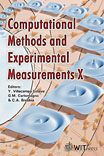Assessment Of Algorithmic And Control Sensitivities In Pseudodynamic Testing
Price
Free (open access)
Transaction
Volume
30
Pages
10
Published
2001
Size
991 kb
Paper DOI
10.2495/CMEM010861
Copyright
WIT Press
Author(s)
W. Algaard, N. Bichnif, A. Agar
Abstract
Assessment of algorithmic and control sensitivities in pseudodynamic testing W. Algaard, N. Bicanic, A. Agar Department of Civil Engineering, University of Glasgow, U.K. Abstract Software based implementation system for pseudodynamic testing realised within the LabView environment is discussed with an assessment of algorithmic and control sensitivities in the SDOF set-up. On the algorithmic level these include the effect of the type of time integration scheme and time step size, while the control effects are concerned with the method and rate of loading, controller capabilities and instrumentation accuracy. The sensitivities are illustrated in two model problems, an inelastic reinforced concrete column and an elastic steel column. 1 Introduction Pseudodynamic testing is a combined computational/experimental technique for evaluating dynamic systems, originally proposed by Takanashi el al. in 1975 [1]. The method relies on modelling inertial and damping forces computationally
Keywords





